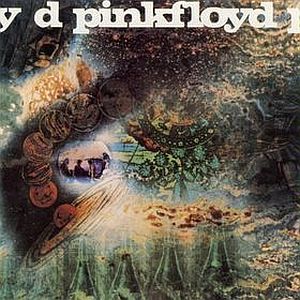
BY HASAN MURAT SÜMER (EE/IV)
hasan.sumer@ug.bilkent.edu.tr
Pink Floyd can easily sit in the same room with the Beatles, Elvis Presley, Michael Jackson, etc. in terms of popularity. “Another Brick in The Wall” is pretty familiar to almost every teenager, and “Dark Side of The Moon” (DSoTM, 1973) is often considered one of the greatest albums ever. Today’s listeners usually know Pink Floyd through DSoTM, which had huge commercial success upon its release, and the albums the band recorded after that. However, almost half of their music was recorded before DSoTM, and this first part of their discography differs significantly in style from the second part. Let’s take a little trip back to their earlier music.
Their first lineup was led by Syd Barrett, who basically created their first album, “The Piper at The Gates of Dawn,” in 1967. It definitely does not tell us anything about what Pink Floyd will become in six years. The album is a fine example of space rock, with psychedelic themes and experimental yet simple song structures. Some of the songs are often labeled by listeners as childish or silly because of the bizarre, seemingly meaningless lyrics and the less complex compositions. But these labels shouldn’t be understood to mean that this is bad music; instead, they contribute to the feel of this being a child’s storybook. In short, Pink Floyd made their debut with an immature and odd yet enjoyable album.
 This bizarre space rock style didn’t last long due to Syd Barrett’s departure after the band’s second album, “A Saucerful of Secrets.” This is a very critical album because David Gilmour and his blues-influenced guitar playing are introduced into the ensemble. I think that Gilmour’s style was the most important factor defining the band’s sound in the following years. Compared to other guitarists working in similar genres at that time, he wasn’t a fast or technical player. But although his playing was slow, it was emotionally rich, and most of his solos have the power to directly affect the listener’s mood. His dominance in the band would become more and more evident with each album. But at this point, the band members were still under Syd Barrett’s influence. As a result, the second album ended up being a more mature version of the previous one. So, there is progress; the music has greater complexity, the guitar work is more pleasing (thanks to Gilmour), and the lyrics have some seriousness in them. Weird bits are still common though, and this will remain the case until the release of DSoTM. A fun bit of trivia about the second album is the fact that Doctor Strange and the Living Tribunal of Marvel Comics are hidden on the cover.
This bizarre space rock style didn’t last long due to Syd Barrett’s departure after the band’s second album, “A Saucerful of Secrets.” This is a very critical album because David Gilmour and his blues-influenced guitar playing are introduced into the ensemble. I think that Gilmour’s style was the most important factor defining the band’s sound in the following years. Compared to other guitarists working in similar genres at that time, he wasn’t a fast or technical player. But although his playing was slow, it was emotionally rich, and most of his solos have the power to directly affect the listener’s mood. His dominance in the band would become more and more evident with each album. But at this point, the band members were still under Syd Barrett’s influence. As a result, the second album ended up being a more mature version of the previous one. So, there is progress; the music has greater complexity, the guitar work is more pleasing (thanks to Gilmour), and the lyrics have some seriousness in them. Weird bits are still common though, and this will remain the case until the release of DSoTM. A fun bit of trivia about the second album is the fact that Doctor Strange and the Living Tribunal of Marvel Comics are hidden on the cover.
The double album “Ummagumma” was released in 1969 as a half live, half studio recording. Opinions on the album are very mixed. This is the first album by Pink Floyd that can be classified as progressive rock. The live side of the album, which contains longer and more ambitious recordings of some of their previous songs, especially impresses me. These are not just live versions of the original studio recordings—they are new pieces of music, which are lengthened and enriched by the experimentation of the musicians. The track “A Saucerful of Secrets” ends with a wordless vocal part (absent in the original version) performed by Gilmour, which is beautiful, painful (not in a bad way) and generally praised. An even better, and louder, version of this vocal part can be heard in the “Live at Pompeii” concert film. “Ummagumma” is an important album where Pink Floyd, for the first time, indicate that they will be making music with greater artistic value in the future (I am ignoring soundtrack albums when making this statement).
The next album, “Atom Heart Mother,” is a giant step in Floyd’s music. Gilmour’s guitar work becomes indispensable here, as we hear him really pushing himself for the first time. The title track, which fills the entire first side of the album, is an instrumental epic with lots of orchestral and experimental work; it also has a lot of influence from the blues. I would venture to say that this track sounds better than the epic “Shine On You Crazy Diamond” from “Wish You Were Here” (1975). The album is a unique one when you consider that Floyd never did a symphonic album such as this again.
I think that if they had continued with this kind of style, they might have ended up being a band similar to The Moody Blues.
In 1971, Floyd released “Meddle.” It is my favorite album of theirs, and they are very close to being perfect here. The first song opens “Meddle” with intense guitar playing and a strong bassline, preparing the listener for a wild, loud album. Unexpectedly, the second song is a relaxing ballad-style work that breaks the first song’s promise; I like this opposition here. The third track is also a relaxed work; it ends with Liverpool fans singing “You’ll never walk alone,” which I think is a very interesting idea. The album’s main weapon is its final track, which takes up its entire second side: the mighty “Echoes.” It takes place in a dream, in which is seen an echoing cave with a cool lake inside (completely my own feelings). It includes Gilmour’s first “legendary” guitar solo and lots of electronic effects that simulate the feeling of being around water. Sadly, because of its length, it also is the reason why the album was not the band’s first huge commercial success; lengthy pieces don’t stand a chance with the average listener.
And two years later, “Dark Side of The Moon” was released.
